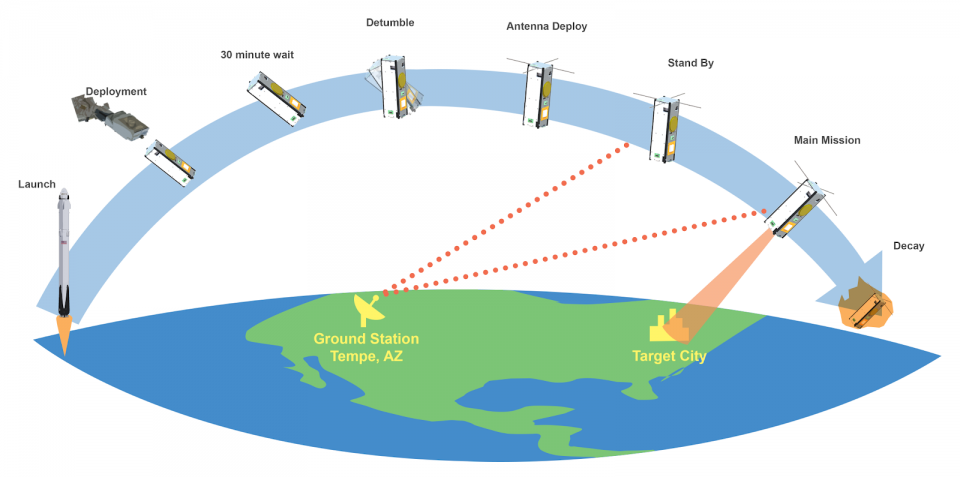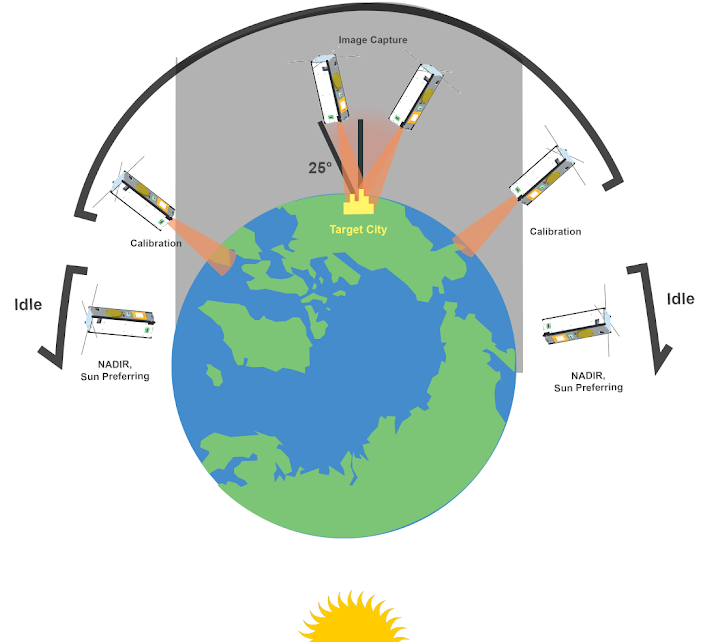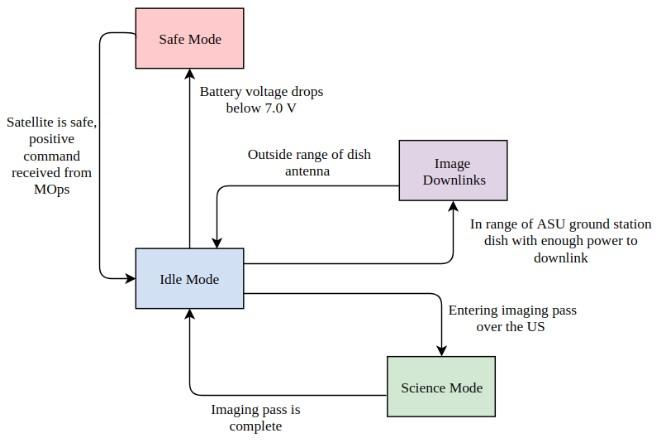Concept of Operations
Operations Overview
Launch & Deployment
Following the launch from Wallops Island in Virginia, the Phoenix CubeSat will sit on the ISS for a few months before deployment in late January 2020. As several cubesats will be deployed close to Phoenix, there is a required 30 minute wait period in which the satellite is not allowed to transmit or perform operations of any kind. This allows CubeSats to spread out from one another after deployment to prevent any kind of interference.
Once the satellite has deployed from the ISS, it will be tumbling in space. After the 30 minute wait period, Phoenix will initialize its attitude control and determination system (ACDS), which will use a set of reaction wheels and magnetorquers to slow the spacecraft down to the point where it can be stabilized.This process is known as detumbling. Phoenix will then be oriented with its camera pointed down toward the earth (Nadir) to minimize atmospheric drag.
Initial Operations Phase
The main mission will not start immediately after deployment. Some time during the beginning of the mission will need to be spent verifying where the spacecraft is in orbit so that we can predict its trajectory in the future. Once Phoenix has been identified, there will be a brief “checkout” phase, in which mission operators will monitor the health of the spacecraft to ensure all hardware is healthy following following launch and deployment. Finally, the checkout phase will be used to test operational procedures, such as collecting test images of Phoenix, AZ to compare how the satellite performs in LEO with how it performed in a laboratory setting. Once the satellite has been officially declared healthy and all operational procedures have been validated on orbit, the primary mission can begin and Phoenix can start collecting images of other US cities.
Disposal
During the operations phase, the spacecraft’s orbit will slowly decay due to atmospheric drag. After two years in LEO, Phoenix will re-enter the Earth’s atmosphere and disintegrate. While Phoenix will be in space for a few years, its operational lifetime is baselined at six months, as this is a typical mission lifetime for CubeSats in LEO.

Satellite Operational Modes
To support the primary and secondary mission objectives, Phoenix has four primary modes of operation:
Idle mode
Idle mode is the primary mode of the spacecraft, in which the satellite charges the battery and collects heartbeat information.
Science Mode
Science mode consists of payload calibration and image capture of a target city. The camera shall be calibrated before all images are taken to aid in post-processing and ensure that any scientific investigation done during the course of the mission can be supported.
Image Calibration
Image calibrations will be done to the Atlantic Ocean before the start of the imaging pass, and to the Pacific ocean after the imaging pass has complete. The temperature along the coast is monitored and can be obtained for post-processing. Therefore, as both the temperature and emissivity of the water are known, the ocean is able to serve as a reliable source for on-orbit calibration throughout the course of the mission.
Imaging Operations
To capture an image of a city, the spacecraft is commanded to track the city's lat/long coordinate and take an image when positioned directly above the target. A set of three reaction wheels are contained in the satellite’s attitude control and determination system (ADCS) allow the camera to remain pointed at the specified ground target while the rest of the satellite continues to move along its trajectory. Earth horizon sensors and an onboard magnetometer allow the satellite to monitor its orientation above the Earth to further help control the spacecraft’s motion during this task. This method of fine pointing and control greatly reduces image blur and allows the spacecraft to obtain a high resolution image of the Earth.
Imaging must occur within a 25deg window from the target location to maintain relative accuracy of the measured ground temperatures, as reflections off of buildings could interfere with the temperatures obtained by the payload. Once an image is captured, it is then named based on the date and time at which it was taken and transferred to the satellite’s onboard computer for storage. The image will be downlinked by the mission operations team at the earliest convenience.
Image Downlink
Longer passes over the ground station are used for downlinking images. During this time, the satellite downlinks as much of an image as possible before leaving the line of sight of the ground station. A downlink of a 321kB image takes approximately 8 minutes, so image downlinks will need to be completed over the course of multiple passes.
Safe Mode
Safe mode occurs when the hardware experiences an event or fault which requires operations to be restricted for a period of time until the spacecraft is declared healthy again. These events could occur due to
Battery voltage drops below 7.0V
Hardware is getting dangerously close to its Allowable Flight Temperature (AFT)
Loss of communications with a component
Off-nominal telemetry or power draw
In the event of safe mode, the operators must assess what sequence of operations would keep the satellite safe and try to resolve the issue if possible.

Mode Transitions
The transitions between the modes discussed above are summarized in the image below:
